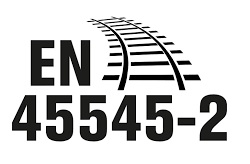In this article:
- EN45545-2 Requirements for Materials & Components
- Hazard Levels
- Testing
- How to Select Rail Components
The European railway standard for fire safety EN45545-2 was introduced as a mandatory requirement throughout Europe. Today, all materials used in rail vehicle manufacturing must follow the EN 45545-2 standard to achieve the highest level of safety possible in the event of a fire.
Existing UK fire regulations such as BS 6853 can no longer be used to prove the compatibility of fire behaviour. The European safety standard EN45545-2 aims to protect passengers and staff against onboard fire incidents in railway vehicles. The standard affects manufacturers of rail vehicles, including high-speed trains, regional trains, trams, Metros and double-decker trains.

EN45545-2 Requirements for Materials & Components
Part two of the European standard; EN45545-2 defines tighter requirements for the fire behaviour of materials and components, including flooring, seats and cables on railway vehicles.
This part specifies the test methods, conditions, and reaction to fire performance requirements.
Adhesives and potting materials for components must be tested and comply with the requirement. The user must find out the product requirements for their application.
Products are classified according to 26 requirement sets (R1-R26) depending on where the materials are used. Each requirement has a corresponding series of test performance criteria.
Examples of product requirements:
- R1 requirements for horizontal/vertical interior surfaces, e.g. ceiling and walls, window frames or display screens.
- R22 / 23 requirements for interior seals, inductance coils, and contacts.
- R24 / 25 requirements for printed circuit boards
- R26 requirements for small electronic products
Hazard Levels
Railway vehicles are classified following the fire hazard level associated with their design and operation. There are three hazard levels; HL1, HL2 and HL3, with HL1 being the lowest requirement and HL3 being the highest.
The classification depends on how many kilometres the trolley is in tunnels and whether it is automatic, two-storey or if sleepers are on board.
Testing
A series of tests are used to measure how the product compares to the product requirement sets. Some test methods include:
- TO1 Oxygen Index
- 03 Flue gas density
- T12 Smoke toxicity
Key parameters include flame spread, ignitability, heat release, smoke opacity and toxicity. Having passed the tests, the adhesive, sealant and product for moulding and protecting electronics are approved according to EN 45545-2 for train use. A test report will indicate which tests the adhesive and/or punching material has been approved.
How to Select Rail Components
- Determine which product requirements apply (R1-R26)
- Determine the fire hazard level (HL1-HL3)
- Identify a suitable material that meets the above ratings and the technical specifications for the application.
- Assured Systems can recommend suitable products that meet your requirement set and have been tested and approved according to EN 45545-2.
For the latest news on EU rail directives, please visit the European Commission website.